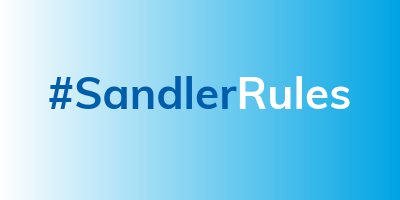
In my continuing series on the Sandler Rules, let’s talk about Sandler Rule number 33, “On your way to the bank, keep one eye over your shoulder.”
If you’ve ever lost a sale after you thought you closed it, then this post is for you.
There’s no shame in having made this mistake, but you should definitely take the time and figure out how to learn from it, so that it doesn’t happen again.
I have a process that’s a little different from other salespeople, but it’s effective for me. Allow me to share it with you.
I really “close” the sale before, instead of during, the fulfillment step.
If that doesn’t make sense, stick with me.
Usually, the sale falls through for two reasons.
1. There are hidden decision makers. Some of these decision makers include:
a) An incumbent supplier
b) A higher-up or spouse
c) A committee or board
Now, it can be tricky to ask about hidden decision makers. You don’t want to imply that the person you’re talking to isn’t in charge or isn’t high enough up to making decisions.
You need to be sensitive.
When I ask, I phrase it along the lines of “Just for clarity, and I don’t mean to step on anyone's toes, but is there anyone that has influence over this decision that should be at this meeting? Perhaps, someone that has veto power?”
When people don’t ask, they fail to get clarity on something that could potentially delay or derail the sales process. Additionally, the salesperson has the least amount of information, and you want to be equal to the prospect.
For example, you don’t want to go into a meeting and give a presentation only to find out that another person will have to see it in a week.
The second reason is that people fail to agree on what a “yes” means.
A part of my decision-making step is to hammer down what exactly will happen at the fulfillment step.
Obviously, the prospect still has the decision to say “no” at fulfillment, but if they say “yes,” you both need to know what those next steps are.
For me, those next steps are:
• Signing the agreement
• Bringing the down payment to the fulfillment meeting
• Scheduling their DiSC® assessment, first Foundations class, and our RECON meetings
While your next steps will be different, both you and your prospect need to agree on what they are. Otherwise, your sale could fall apart at fulfillment.
By doing this, I don’t have to worry about looking over my shoulder or about any hidden agendas, and I know that the meeting will run smoothly.
Before I end this post, there is one more thing I want to mention. If more than a week passes between your last meeting and the fulfillment date, I always send an email confirmation the day before the meeting.
In this email, I ask the prospect if we’re still on or if anything has changed.
This allows both of us a chance to reaffirm our interest and schedules.
If you learn anything through this post, I hope it’s this: You have to close the sale before the fulfillment step. Otherwise, you could lose your money on your way to the bank.

